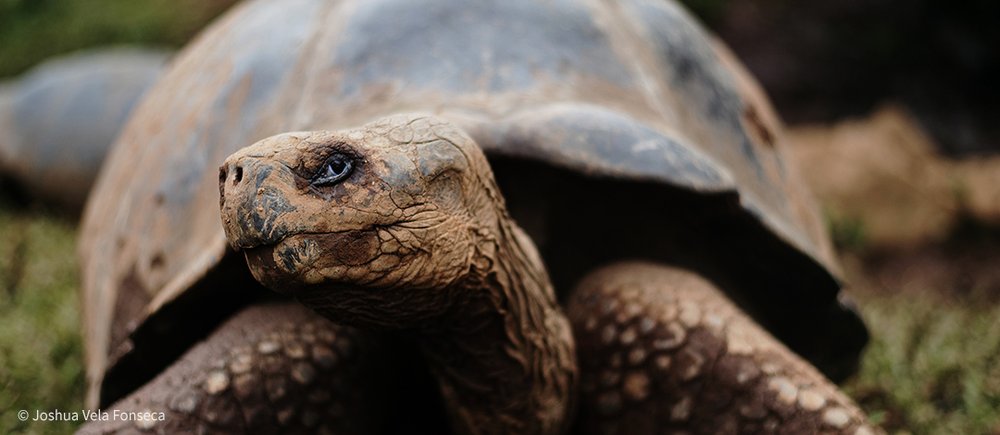
Last July, members of the Galapagos Tortoise Movement Ecology Programme (GTMEP) spent a week in Alcedo Volcano, one of the biggest volcanoes of the Galapagos Islands and home of the largest population of giant tortoises. Our main goals were to collect the telemetry data from the 11 tortoises with our GPS tags that we have been studying for the past 8 years, and to collect samples of up to 70 tortoises, to better understand their health status in this remote natural heritage in the middle of the Pacific Ocean.
The GTMEP programme is a collaborative effort between the Galapagos National Park Directorate (GNPD), Charles Darwin Foundation (CDF), Saint Louis Zoo Institute for Conservation Medicine, Max Planck Institute for Ornithology, Galapagos Conservation Trust (GCT) and Houston Zoo.
The team included two wildlife veterinarians (Dr. Sharon Deem and Ainoa Nieto Claudin), the project field biologist Freddy Cabrera and Jose Haro, one photographer (Joshua Vela) and a CDF volunteer (Surya Castillo). Two local porters (Manuel Haro and Unler Greffa) completed the team.
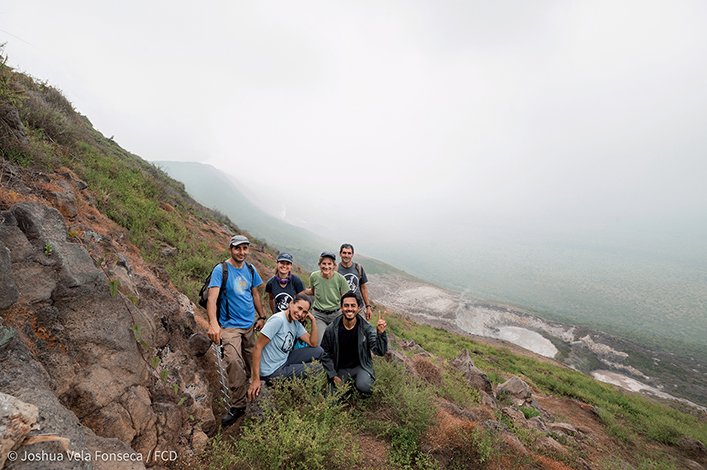
The trip started with months in advance, by obtaining all permits, buying the equipment and supplies and performing the quarantine process. Finally, on July 17th the team sailed at 5h00 on its way to Isabela Island. After disembarking at Cowley beach we had to hike to the top of the volcano. The ascent, as you can imagine, was not easy. Carrying medical equipment, food, oil and positive state of mind; also a generator, one centrifuge and a portable cooler on our backs, we walked for 7hours to the crater rim. A trail not often used, it seemed to be designed more for tortoises than for humans, when you can easily observe the drastic changes of the vegetation: from arid and deserted areas, suddenly to cat´s claw forest and dense ferns taller than us.
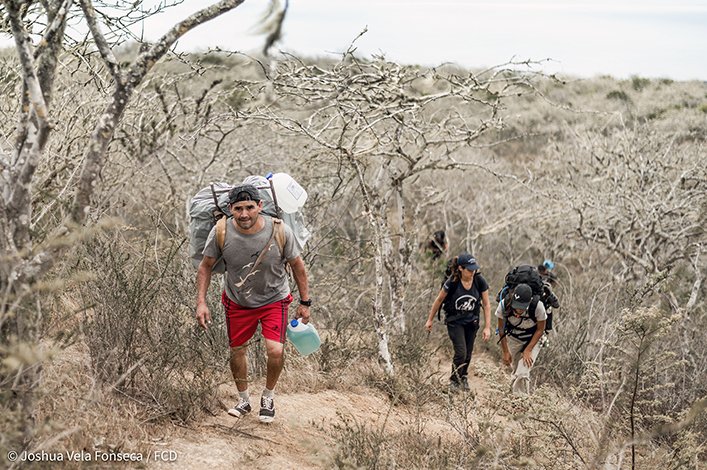
The “Linda Cayot” camp welcomed us at nightfall, surrounded by a dense fog. After several months of non-human presence, the hut was colonized by rats and other vermin, emanating a strong damp and urine smell. A quick cleaning, warm meal and the fatigue accumulated helped to beautify the place. That night we all slept like a logs!
We woke up at daybreak, and we started our first day of health sampling. Around the camp, a number of big male tortoises were taking turns waking up to “mow” the lawn as they too ate their breakfast. We could not choose better gardeners!
Dr. Deem supervised our work; with more than 20 years of experience working on conservation medicine projects with wildlife species across the globe, she got very excited to be in Alcedo: “we are making history, we are collecting samples to understand the health of Galapagos tortoises from this very remote volcano”. And she emphasized: “to understand how to conserve these giants in their natural habitat, it is extremely important to understand and minimize the health threats they face in the 21st Century.”
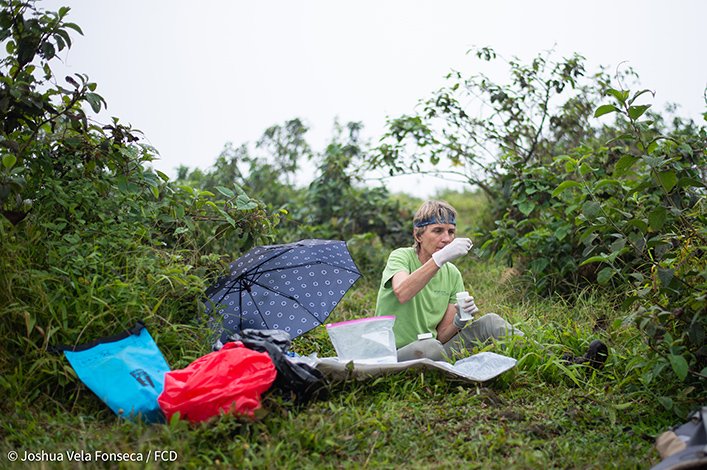
Days went very fast. Early breakfast followed by long hikes collecting samples from tortoises along the edge of the crater; often being battered by the wind and “garúa” until the sun would suddenly appear at midday. At that moment on most days, the clouds would disappear and the volcano would show its majesty. Big fumaroles like heavy sighs came from the inside of the crater and uncountable tortoise carapaces of all sizes shined under the sun. The hawks, curious, surprised us with their aerial dances, attempting to reach our heads. Work extended until the afternoon, when we all went back to our improvised home, carrying tortoise blood, feces, swabs and ecto-parasite samples. Some of the samples, such as the blood, needed to be process immediately, at our makeshift laboratory. Equipped with a torch, a pair of gloves and lot of patience, the veterinary contingent of the team, Drs. Deem, Nieto Claudin, and Surya, worked for the next few hours processing all samples and collecting the data. The portable generator was also working full-time, ensuring power supply to use the lab equipment and keeping the samples cold within the freezer.
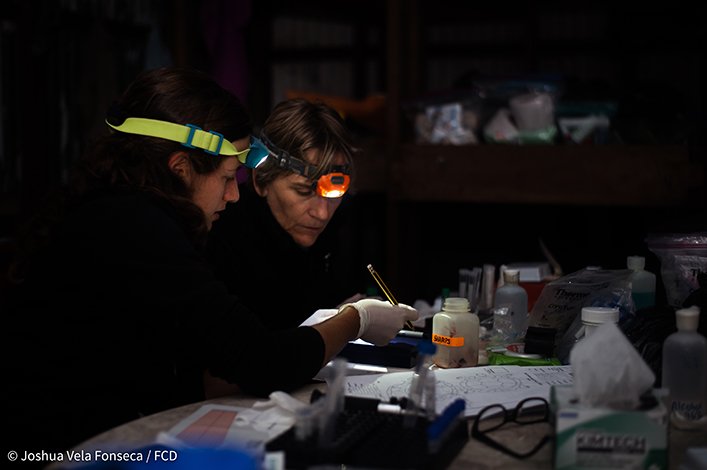
Five days of intensive field work, long hikes to find tagged tortoises and a number of hours at night processing samples gave us a total of 71 tortoises safely sampled from around the volcano. Also, 8 of the 11 tortoises tagged with GPS devises were found and their data downloaded. On the seventh day, it was time to go back to Santa Cruz. We set out at day break, again with backpacks full of equipment but more importantly with biological samples and photos and memories to last a life time, we set out on our way down. The volcano gave us a last gift: a stunning view of the whole crater and over the skyline, all volcanoes from Isabela, Fernandina and Santiago Islands. All our effort was worthwhile.
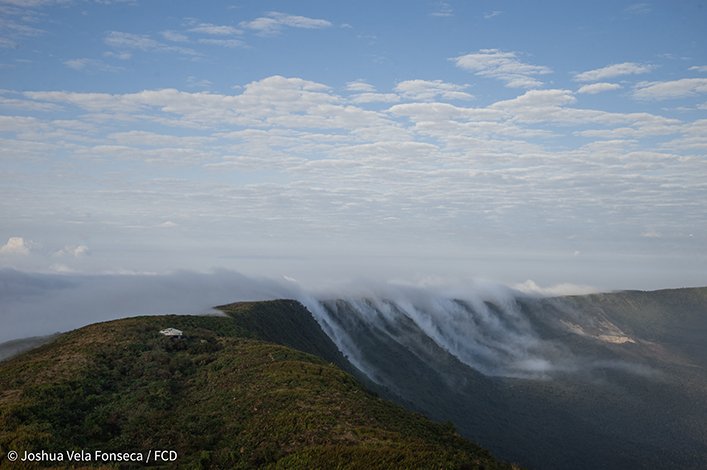
Stay tuned to learn about our results from this health research! In the next few months we will process all samples with several diagnostic tools and will get the health data from these ancient tortoises, and will send a new update.
If you want to learn more about this project visit: www.gianttortoise.org
Email: cdrs@fcdarwin.org.ec





